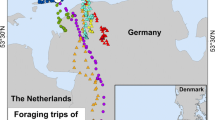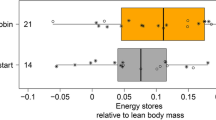Abstract
GPS transmitters were used with the Argos satellite system to track two Light-bellied Brent Geese (Branta bernicla hrota) from Iceland to Arctic Canada, three Greenland White-fronted Geese (Anser albifrons flavirostris) from Scotland to west Greenland, and two Barnacle Geese (Branta leucopsis) from Scotland to Spitsbergen. Each goose’s wing span was measured at the time of tagging, and its body mass and fat fraction were estimated at the time of departure. This was the starting point for the Flight program’s time-marching simulation, which is a non-statistical procedure based on flight mechanics. The ground speed was measured between each GPS fix and the previous one, and combined with a wind estimate to find the air speed. The program calculated the power, using the air density from the GPS altitude. The rates of consumption of fat and muscle tissue were calculated from the power, and used to update the body mass and composition. The total air distance flown by each bird was not consistently less than the ground distance, and there was no indication that the birds could select their routes, or even their timing, so as to bias the wind in their favour. Rates of climb when ascending the Greenland Ice Cap were very low in the Brent Geese, in relation to the maximum rate of climb of which the flight muscles were expected (on mechanical grounds) to be capable of supporting. The Brent Geese stopped often during the ice crossing, suggesting that they could not sustain sufficient aerobic power for continuous flight. The fat fractions of the White-fronted Geese were lower across the ice cap, and they climbed faster and stopped less often. Energy height was used as a species-independent measure of energy reserves. All seven northbound geese arrived in their nesting areas at estimated energy heights exceeding 200 km (around 350 km for the two Brent Geese). All of the geese achieved average energy gradients of at least 11, including short stops, meaning that their arrival energy heights were sufficient to fly a further 2,200–4,000 km. We propose that these reserves represent the energy height needed to initiate successful breeding in these arctic habitats, with an element of insurance against contrary winds.











Similar content being viewed by others
References
Anderson JO (1991) Fundamentals of aerodynamics. McGraw Hill, New York
Gill RE, Tibbitts TL, Douglas DC, Handel CM, Mulcahy DM, Gottschalck JC, Warnock N, McCaffery BJ, Battley PF, Piersma T (2009) Extreme endurance flights by landbirds crossing the Pacific Ocean: ecological corridor rather than barrier? Proc R Soc Lond B 276:447–457
Glahder CM, Fox AD, Walsh AJ (1999) Satellite tracking of Greenland white-fronted geese. Dan Odontol Foren Tidskr 93:271–276
Griffin LR (2008) Identifying the pre-breeding areas of the Svalbard Barnacle Goose Branta leucopsis between mainland Norway and Svalbard: an application of GPS satellite-tracking techniques. Vogelwelt 129:226–232
Gudmundsson GA, Benvenuti S, Alerstam T, Papi F, Lilliendahl K, Åkesson S (1995) Examining the limits of flight and orientation performance: satellite tracking of brent geese migrating across the Greenland ice-cap. Proc R Soc Lond B 261:73–79
Hedenström A, Alerstam T (1992) Climbing performance of migrating birds as a basis for estimating limits for fuel-carrying capacity and muscle work. J Exp Biol 164:19–38
Jenni L, Jenni-Eiermann S (1998) Fuel supply and metabolic constraints in migrating birds. J Avian Biol 29:521–528
Lindström Å, Piersma T (1993) Mass changes in migrating birds: the evidence for fat and protein storage re-examined. Ibis 135:70–78
Obrecht HH, Pennycuick CJ, Fuller MR (1988) Wind tunnel experiments to assess the effects of back-mounted radio transmitters on bird body drag. J Exp Biol 135:265–273
Pennycuick CJ (1998) Computer simulation of fat and muscle burn in long-distance bird migration. J Theor Biol 191:47–61
Pennycuick CJ (2001) Speeds and wingbeat frequencies of migrating birds compared with calculated benchmarks. J Exp Biol 204:3283–3294
Pennycuick CJ (2008) Modelling the flying bird. Elsevier, Amsterdam
Pennycuick CJ, Battley PF (2003) Burning the engine: a time-marching computation of fat and protein consumption in a 5420-km flight by great knots (Calidris tenuirostris). Oikos 103:323–332
Pennycuick CJ, Klaassen M, Kvist A, Lindström Å (1996a) Wingbeat frequency and the body drag anomaly: wind tunnel observations on a thrush nightingale (Luscinia luscinia) and a teal (Anas crecca). J Exp Biol 199:2757–2765
Pennycuick CJ, Einarsson O, Bradbury TAM, Owen M (1996b) Migrating whooper swans (Cygnus cygnus): satellite tracks and flight performance calculations. J Avian Biol 27:118–134
Pennycuick CJ, Bradbury TAM, Einarsson Ó, Owen M (1999) Response to weather and light conditions of migrating whooper swans Cygnus cygnus and flying height profiles, observed with the Argos satellite system. Ibis 141:434–443
Piersma T, Gill RE (1998) Guts don’t fly: small digestive organs in obese bar-tailed godwits. Auk 115:196–203
Tucker VA (1968) Respiratory physiology of house sparrows in relation to high-altitude flight. J Exp Biol 48:55–66
Acknowledgments
It is a pleasure to thank Julian Hector, Head of Radio Broadcasting in the BBC Natural History Unit, Bristol, who devised and directed the World on the Move radio series, financed the satellite tracking in conjunction with the Solway Coast Area of Outstanding Natural Beauty Sustainable Development Fund, and co-ordinated the whole operation, and Baz Hughes who co-ordinated the Wildfowl and Wetlands Trust (WWT) side of the project. We are especially grateful to Guðmundur Guðmundsson of the Icelandic Institute of Natural History for allowing us to take part in the Brent Goose research project, to Nigel Jarrett of WWT for setting up the wing-measuring operation at Slimbridge, and to Richard Hesketh, staff and volunteers at WWT Caerlaverock who, along with the North Solway Ringing Group, assisted with the Barnacle Goose catches. The activities described in this paper complied with United Kingdom and Iceland law.
Author information
Authors and Affiliations
Corresponding author
Additional information
Communicated by A. Hedenström.
Rights and permissions
About this article
Cite this article
Pennycuick, C.J., Griffin, L.R., Colhoun, K. et al. A trial of a non-statistical computer program for monitoring fuel reserves, response to wind and other details from GPS tracks of migrating geese. J Ornithol 152 (Suppl 1), 87–99 (2011). https://doi.org/10.1007/s10336-010-0633-6
Received:
Revised:
Accepted:
Published:
Issue Date:
DOI: https://doi.org/10.1007/s10336-010-0633-6




